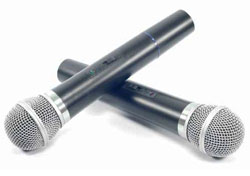
Knowing The Rules
As wireless operators, we’re at a point in time where the only way to achieve success will be to continually know what the rules are. And yes, they are changing.
For example, the next auction will place everything above 600 MHz on the chopping block. This means that we’ll lose another 100 MHz of UHF spectrum. At that point, wireless will literally need to be “reinvented” from a manufacturing standpoint to survive.
Wireless system makers are well aware of this fact. Between the introduction of digital wireless mics from AKG, Shure, Sennheiser, and Line 6, and the return to the VHF band for wireless intercoms from Radio Active Designs (a company I’m involved with), we’re seeing a rebirth of technologies in the audio community. This new approach represents a necessary evolution in our industry and has been brought on by the catalyst of FCC spectral changes and digital consumer technology.
As the majority of consumer digital technology will be in the UHF band, it’s a good idea to seek safe harbor in the VHF band wherever possible. This may include placing IFB systems in the 76-88 MHz band and intercom systems in the 174-216 MHz band. Between these two, you can buy yourself an additional 100 frequencies and get some “wiggle room” up in the UHF band for your wireless mic systems.
I’ve worked with the new digital wireless microphone systems from all of the professional manufacturers and can make a usable observation. A digital wireless system will always be more tolerant to interference than an analog wireless system. All analog wireless systems in the U.S. use Frequency Modulation (FM) technology.
Though FM sounds great and has no latency, it is not very forgiving when it comes to interference rejection. In fact, the slightest interference may cause an FM system to become unusable. The digital wireless systems on the market today are extremely tolerant to interference and can operate with a very high general noise floor inside of their radio band.
Since the portable white space devices will be everywhere in your audiences, my feeling is that they will consistently create intermodulation distortion products that may cause interference that’s harmful to wireless systems. Remember, these smartphones will be in the same radio spectrum as your wireless mics. It really seems to make sense then that any equipment placed in this band should be as tolerant to interference as possible. (Hello digital wireless mic systems!)
Planning For Success
Let’s bring things all together. Wireless audio system operation has gotten more and more difficult over the last few years. It will be even more difficult in the coming years.
Know where to operate for your best chance for success. Spread out wireless systems in frequency with proper radio band planning. Use VHF wherever possible for wireless IFB and intercom systems. Budget for digital wireless mics over the next few years.
Review the latest rules regarding where wireless audio devices and white space devices may operate. Know the two 6 MHz channels that are reserved for wireless audio in your city or cities of operation. Keep IEM transmitters in one of those 6 MHz chunks and wireless mics in the other to maximize signal-to-noise ratio, distortion, and audio quality.
And finally, stay informed about possible upcoming changes and new technologies. Stay tuned!
James Stoffo is the founder of Professional Wireless Systems and a founding member of Radio Active Designs. He continues to work as the RF technician and frequency coordinator on large-scale special events and installations.
